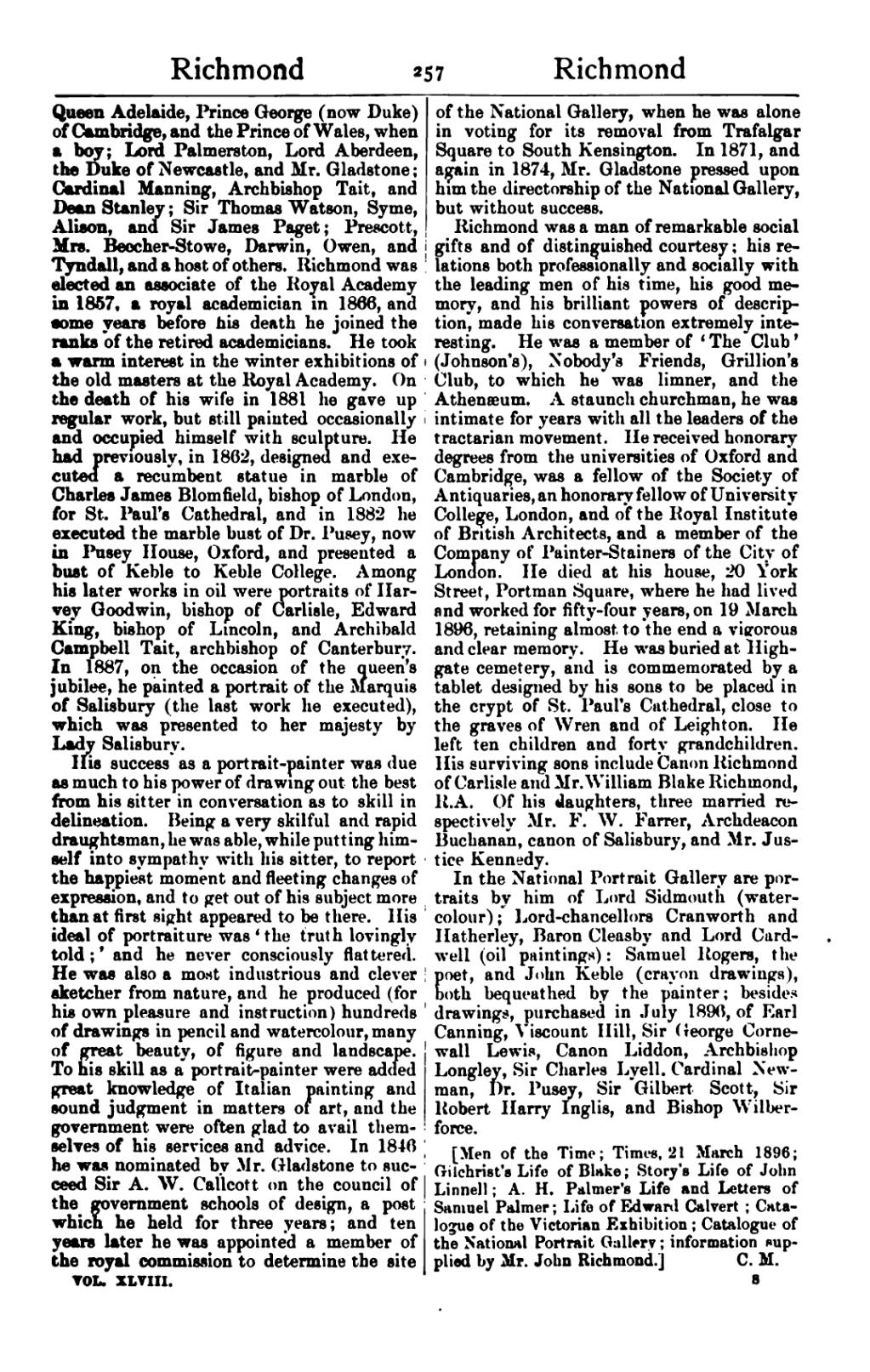Queen Adelaide, Prince George (now Duke) of Cambridge, and the Prince of Wales, when a boy; Lord Palmerston, Lord Aberdeen, the Duke of Newcastle, and Mr. Gladstone; Cardinal Manning, Archbishop Tait, and Dean Stanley; Sir Thomas Watson, Syme, Alison, and Sir James Paget; Prescott, Mrs. Beecher-Stowe, Darwin, Owen, and Tyndall, and a host of others. Richmond was elected an associate of the Royal Academy in 1857, a royal academician in 1866, and some years before his death he joined the ranks of the retired academicians. He took a warm interest in the winter exhibitions of the old masters at the Royal Academy. On the death of his wife in 1881 he gave up regular work, but still painted occasionally and occupied himself with sculpture. He had previously, in 1862, designed and executed a recumbent statue in marble of Charles James Blomfield, bishop of London, for St. Paul's Cathedral, and in 1882 he executed the marble bust of Dr. Pusey, now in Pusey House, Oxford, and presented a bust of Keble to Keble College. Among his later works in oil were portraits of Harvey Goodwin, bishop of Carlisle, Edward King, bishop of Lincoln, and Archibald Campbell Tait, archbishop of Canterbury. In 1887, on the occasion of Queen Victoria's jubilee, he painted a portrait of the third Marquis of Salisbury (the last work he executed), which was presented to the queen by the marquis's wife.
His success as a portrait-painter was due as much to his power of drawing out the best from his sitter in conversation as to skill in delineation. Being a very skilful and rapid draughtsman, he was able, while putting himself into sympathy with his sitter, to report the happiest moment and fleeting changes of expression, and to get out of his subject more than at first sight appeared to be there. His ideal of portraiture was ‘the truth lovingly told;’ and he never consciously flattered. He was also a most industrious and clever sketcher from nature, and he produced (for his own pleasure and instruction) hundreds of drawings in pencil and watercolour, many of great beauty, of figure and landscape. To his skill as a portrait-painter were added great knowledge of Italian painting and sound judgment in matters of art, and the government were often glad to avail themselves of his services and advice. In 1846 he was nominated by Mr. Gladstone to succeed Sir A. W. Callcott on the council of the government schools of design, a post which he held for three years; and ten years later he was appointed a member of the royal commission to determine the site of the National Gallery, when he was alone in voting for its removal from Trafalgar Square to South Kensington. In 1871, and again in 1874, Mr. Gladstone pressed upon him the directorship of the National Gallery, but without success.
Richmond was a man of remarkable social gifts and of distinguished courtesy; his relations both professionally and socially with the leading men of his time, his good memory, and his brilliant powers of description, made his conversation extremely interesting. He was a member of ‘The Club’ (Johnson's), Nobody's Friends, Grillion's Club, to which he was limner, and the Athenæum. A staunch churchman, he was intimate for years with all the leaders of the tractarian movement. He received honorary degrees from the universities of Oxford and Cambridge, was a fellow of the Society of Antiquaries, an honorary fellow of University College, London, and of the Royal Institute of British Architects, and a member of the Company of Painter-Stainers of the City of London. He died at his house, 20 York Street, Portman Square, where he had lived and worked for fifty-four years, on 19 March 1896, retaining almost to the end a vigorous and clear memory. He was buried at Highgate cemetery, and is commemorated by a tablet designed by his sons to be placed in the crypt of St. Paul's Cathedral, close to the graves of Wren and of Leighton. He left ten children and forty grandchildren. His surviving sons included Canon Richmond of Carlisle and Sir William Blake Richmond, K.C.B., R.A. Of his daughters, three married respectively Mr. F. W. Farrer, Archdeacon Buchanan, canon of Salisbury, and Mr. Justice Kennedy. In the National Portrait Gallery are portraits by him of Lord Sidmouth (watercolour); Lord-chancellors Cranworth and Hatherley, Baron Cleasby and Lord Cardwell (oil paintings); Samuel Rogers, the poet, and John Keble (crayon drawings), both bequeathed by the painter; besides drawings, purchased in July 1896, of Earl Canning, Viscount Hill, Sir George Cornewall Lewis, Canon Liddon, Archbishop Longley, Sir Charles Lyell, Cardinal Newman, Dr. Pusey, Sir Gilbert Scott, Sir Robert Harry Inglis, and Bishop Wilberforce.
[Men of the Time; Times, 21 March 1896; Gilchrist's Life of Blake; Story's Life of John Linnell; A. H. Palmer's Life and Letters of Samuel Palmer; Life of Edward Calvert; Catalogue of the Victorian Exhibition; Catalogue of the National Portrait Gallery; information supplied by Mr. John Richmond.]
